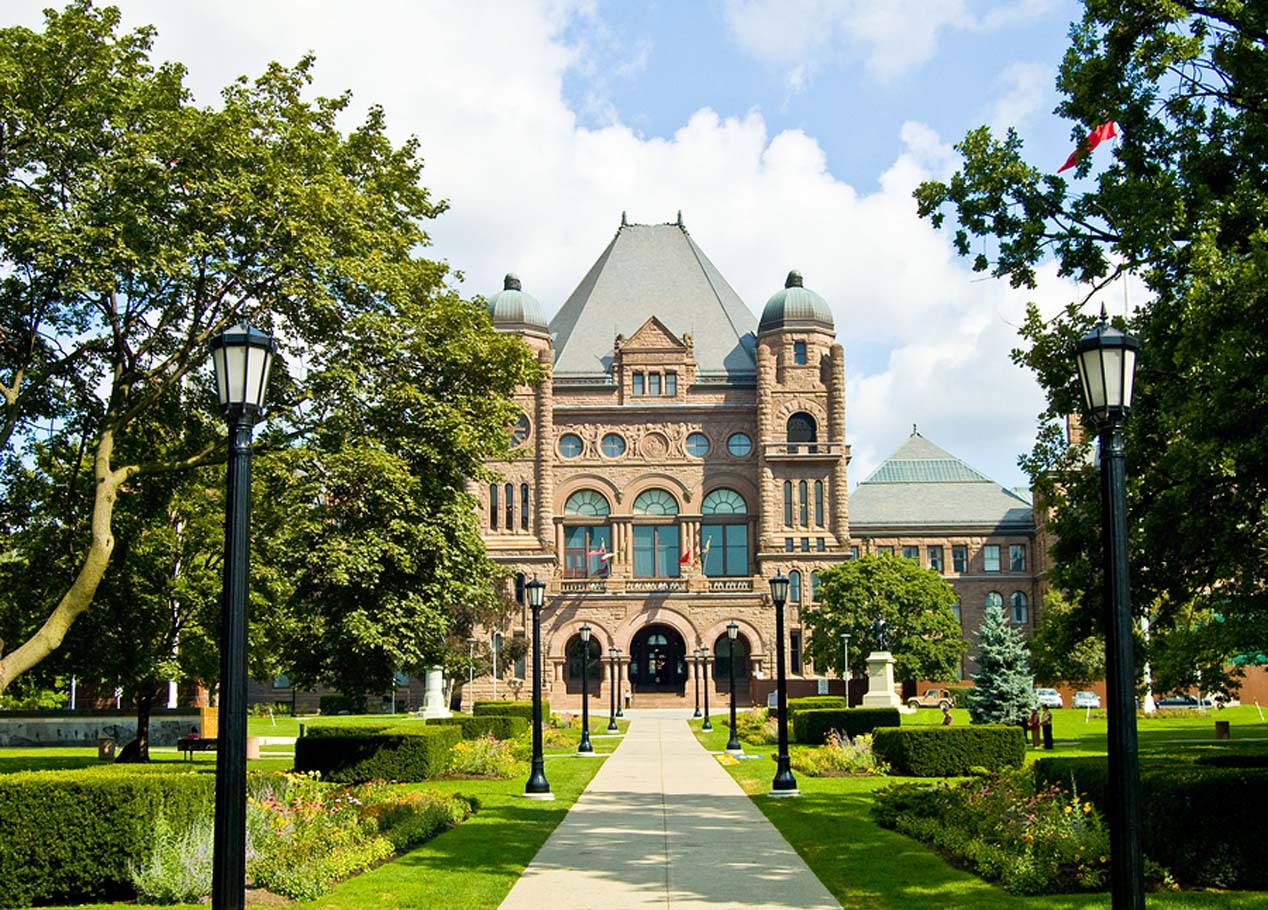Ontario (ON) Budget 2023 Highlights for Provincial Funding Programs
The provincial government of Ontario unveiled their Budget 2023 plans, titled “Building a Strong Ontario.” The budget includes total spending of $204.7 billion and supports several of the government’s ongoing goals including attracting new manufacturing jobs to Ontario, investing in critical minerals and infrastructure, and supporting the healthcare workforce.
Want to learn more about other provincial and federal budget updates from 2023? Check out our 2023 budget highlights page for a collection of reviews.
The initiatives in the Ontario 2023 Budget are divided into two broad sections: “Building Ontario” and “Working for You.” The former includes plans for a new “Ontario Investment Office”, an Ontario Made Manufacturing Investment Tax Credit, and a voluntary clean energy credit. The latter includes investments in critical minerals, skills and jobs, clean technology initiatives, and a digital tax platform.
Overall, the Ontario 2023 Budget has a significant focus on creating jobs across the province, improving highways and public transit, healthcare and education, clean energy, and affordable housing. There are no new tax increases announced in the budget, although some tax credits will be phased out. The Ontario government is forecasting a deficit of $25.6 million for 2023 but plans to balance the budget by 2025, with a surplus of $200 million by next year’s budget.
By planning prudently, and focusing our investments, we have made considerable progress on our path to balance. In fact, we now plan to balance the Budget in 2024–25, three years earlier than expected in the last Budget. Because of our thoughtful, transparent planning, we can do this while still delivering on our Plan to Build to support families, workers, and businesses across Ontario. This is why we are continuing with our responsible, targeted approach that is building an Ontario that the people of this province can be proud of, not only today but in the future.
The Honourable Peter Bethlenfalvy, Ontario’s Minister of Finance
Hiring Wage Subsidies & Training Grants
The Ontario budget 2023 is investing significant funds towards preparing for future economic pressures by increasing the numbers of highly skilled workers to ensure maximum efficiency. These funds will be invested across a variety of programs ranging from training workers on new skills to accelerating the process for certifying skilled immigrants.
- An additional $75 million to the Skills Development Fund over the next three years will help workers, job seekers, and apprentices acquire the skillsto take on new opportunities and advance in their careers;
- There will be $224 million dollars allocated to a new capital stream of the Skills Development Fund to the increase capacity of bricks and mortar training centers, including union training halls. This stream is intended to improve the quality of training workers receive, with a specific focus on increasing the capacity of programs to support the government’s plan to build 1.5 million homes by 2031;
- The government will invest an additional $5 million to launch the second round of the Ontario Microcredentials Challenge Fund, intended to create more microcredential projects. The first round of the fund supported the creation of up to 250 microcredentials;
- The Ontario Immigrant Nominee Program (OINP) will recieve an additional $25 million over the next three years to increase the supply of skilled workers in the province, including in-demand professionals from the skilled trades, which will help address ongoing labour shortages and support economic growth;
- As part of the Ontario Bridge Training Program expansion, $3 million will be allocated to assist internationally trained immigrants in finding employment and gaining faster access to training and support towards obtaining a license or certificate;
- Mitacs, an organization that builds research partnerships between postsecondary institutions and industry, will receive $32.4 million over the next three years to support the creation of 6,500 high-quality research internships; and
- Better Jobs Ontario will recieve $15 millionover three years to ensure the economy is supported with a skilled workforce.
Your business may be eligible for funding to support your hiring and training needs. If you would like to verify your eligibility for some of Canada’s top programs, or learn more about what opportunities are available, contact us today for a free funding discussion.
Funding to Improve Ontario’s Infrastructure
Investments in public infrastructure over the next decade will alleviate gridlock, connect communities, and improve people’s access to jobs and public services.
- Over the next 10 years, the government will invest a total of $27.9 billion to connect communities and alleviate traffic gridlock to stimulate economic growth throughout the country. It is estimated that over the next four years, the Ontario Highways Program will support more than 600 expansions and rehabilitations;
- $70.5 billion over 10 years will be invested in critical public transportation projects to support the province’s economy, alleviate gridlock, connect more people with jobs and housing, and create thousands of new good, local jobs over the next decade;
- Ontario continues to develop internet infrastructure, and estimates that by the year 2025, the province will have invested $4 billion to ensure that every community in the province can access high-speed internet;
- As part of the Ontario Community Infrastructure Fund (OCIF), the government will provide approximately $400 million for roads, bridges, water, and wastewater projects in 2023; and
- The Urban Mobility Vehicle Pilot Program includes the exploration of alternate vehicles as a green and affordable transportation option for local communities willing to participate. Participants are required to pass municipal bylaws to allow the vehicles to be driven on their roads.
Ontario Healthcare Provincial Funding
The Ontario government is determined to establish a more robust health system across the province as residents recover from the impact of COVID-19. Funding for healthcare includes grants and incentives to improve facilities, train staff, and stabilize communities.
- Over the next 10 years, $48 billion will be spent on hospital infrastructure, including $32 billion in capital grants to hospitals to support more than 50 projects and create of 3,000 new hospital beds, increasing access to reliable and quality healthcare;
- The federal government will make a down payment of $4.4 billion from the Canada Health Transfer program over the next three years, along with other time limited funding agreements to be implemented for shared priorities in the future; and
- The annual healthcare budget is $569 million, which includes nearly $100 million for home healthcare and $300 million for contract rate increases to support the stabilization of the home and community care workforce.
A Focus on Key Economic Drivers
Ontario is ensuring that residents and businesses can achieve their economic growth goals, as well as build a sustainable path forward. These building blocks are being supported by a range of programs for critical minerals, clean energy, and small business funding.
Funding for Critical Minerals
- The successful Critical Minerals Strategy program will recieve an additional $3 million each in 2023–24 and 2024–25, helping more companies find mineral deposits and attracting more investors;
- Ontario’s Junior Exploration Program will receive a total of $13 million in 2023-2024 and another $13 million in 2024-2025. An annual Critical Minerals Stream will receive $4 million; and
- The mining industry provides good jobs for Ontarians and will be supported through Ontario’s Critical Mineral Exploration Tax Credit, which offers an estimated $25 million per year in additional relief.
Clean Energy Funding Programs
- An additional $342 million has been allocated for the energy-efficiency programs of the Independent Electricity System Operator (IESO). By investing $650 million more in energy efficiency, families and businesses will be able to reduce their energy consumption and save money on their energy bills, bringing the total to $1 billion; and
- As environmental and sustainability goals increasingly influence corporate decisions, the development of a voluntary clean energy credit registry (CEC) will enhance Ontario’s competitiveness and attract new jobs. By adopting the registry, Ontario will be able to become more attractive as a business location.
- To lower electricity costs and to support future clean energy generation, funds generated from the purchase of CECs will be returned to ratepayers to help lower electricity costs.
Provincial Grants for Ontario Businesses
- In 2023–24, $2 million will be allocated to Futurpreneur Canada, a non-profit that offers mentorship programs and loans up to $25,000 to businesses led by people between the ages of 18 and 39;
- Funding of $15 million over three years will be provided to the Racialized and Indigenous Supports for Entrepreneurs Program (RAISE) that supports Indigenous, Black, and other racialized entrepreneurs;
- The Black Youth Action Plan will receive $3 million to allocate to black youth and entrepreneurs, helping them overcome barriers and participate in the economy;
- New initiatives to promote access to and commercialization of technologies that will fuel innovation, create jobs, and maintain businesses’ competitiveness are being funded with $107 million; and
- To maintain Ontario’s leadership in the financial industry, the government will invest $3 million over the next three years to support effective risk management.
Conservation Funding
- A further $14 million will be allocated to expanding the Greenlands Conservation Partnership in 2023–24, which will enable conservation partners to raise matching contributions from the private sector and protect and manage new, privately owned natural areas, including wetlands, grasslands, and forests, ensuring their preservation for the future.
Agriculture Funding
- Over the next three years, the provincial government has committed $9.5 million for the improvement of soil data mapping, soil evaluation and monitoring, and to support key commitments made under the provincial government’s Agricultural Soil Health and Conservation Strategy for Ontario.
New Ontario Provincial Tax Credit for Manufacturers
Ontario Made Manufacturing Investment Tax Credit
The Province of Ontario has announced the introduction of a 10% refundable Corporate Income Tax credit for certain investments in buildings, machinery, and equipment that are used in manufacturing and processing.
Since capital investment deductions are prevalent in the growth and scaling stages of a company’s global maturity journey, these companies typically cannot leverage traditional tax incentives. Due to its refundable nature, this incentive is attractive to companies investing in real time that have yet to pay significant Part 1 federal taxes, or Ontario taxes. This is what makes this incentive so powerful.
Canadian Controlled Private Corporations (CCPCs) must have a permanent establishment in Ontario and invest in capital property classified as CCA Class 1 (buildings) or Class 53 (machinery and equipment) that becomes “Available for Use” after March 23, 2023, and before 2026 in order to qualify. The CCA class 43(a) would include expenditures for certain machinery and equipment after 2025.
There is a maximum refundable tax credit of $2 Million each year for associated groups of qualified corporations with an annual qualifying investment limit of $20 million.
This initiative is hoped to boost Ontario’s manufacturing industry. To learn more about this tax update and more from the Ontario 2023 budget, read this comprehensive Ryan Tax Alert.
To learn more about tax incentives that Ontario businesses may be eligible for, watch our SR&ED tax credit video below.
Fund Your Ontario Business Activities with Grants, Loans, and Tax Credits
Subscribe to our free government funding newsletter to stay up to date on the latest grants, loans, and tax incentives in your industry. Check out our comprehensive directory of government funding opportunities if you are an Ontario-based business interested in finding out how to apply for government funding.
Furthermore, we strongly recommend businesses to attend one of our free government funding webinars to learn about the top funding programs available across a wide range of industries and business activities.


